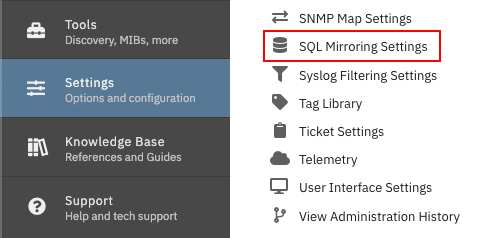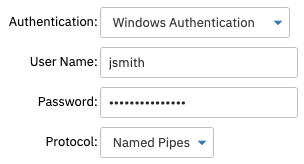FrameFlow's SQL mirroring settings let you integrate the event and graph data on your FrameFlow installation with other systems that exist in your IT environment. The types of data you can integrate with other systems are graph data, event data, and tickets. You can choose which pieces of this information get mirrored to the other systems and which stay behind. This tutorial will teach you how to use SQL mirroring to your advantage!
To begin, go to Settings > SQL Mirroring Settings in your FrameFlow installation.
 Settings > SQL Mirroring Settings
Settings > SQL Mirroring Settings
On that page, you can designate which types of data will be mirrored. Select the types of data you want to mirror to other systems. Leave boxes unchecked besides data types you don't want to mirror. The data types you choose to mirror will be automatically inserted into the required database tables the moment the corresponding box is checked.
 SQL Mirror Data Options
SQL Mirror Data Options
Checking a box in the above section will reveal a dropdown menu containing additional options. Specify the database server you'll be using to mirror your FrameFlow data. This can optionally be the system where you've installed FrameFlow itself, though users with high-volume configurations are encouraged to choose a different system to avoid interfering with monitoring operations. Next, add the database name and instance name, if applicable.
 Dropdown Options
Dropdown Options
After that, configure the authentication settings, where you can choose between Windows authentication and SQL Server authentication. We support all versions of SQL Server from 2014 or later. Finally, if needed, you can change the protocol used to connect to your database.
 Additional Options
Additional Options
Keep in mind that FrameFlow continues to use its local custom datastores for all monitoring, reporting, and dashboard operations. The SQL mirroring option is used to create a dynamic copy of that data stored in your SQL Server database so that you can integrate that data with your other corporate systems and data warehouses.
The average FrameFlow installation can produce thousands of events per day, so users mirroring event data to databases are recommended to have a maintenance script on their SQL Server databases, written in SQL Server language. A maintenance script can help by trimming unneeded data, thereby saving you space in your database.
By default, when creating databases, we don't create indexes for any of the tables or columns. If you plan to query your database, make sure to set that up manually first.
As mentioned, the amount of data gathered by FrameFlow each day can be massive. If you wish to retain all of it for auditing purposes or the like, this is the tool for you. If you'd rather retain only a fraction of this data, you should consider using our rest API instead, which can also retrieve graph, event, and ticket data, but allows you to select only the data you're interested in as opposed to only being able to refine by data type as you can here. That way, the script you write can use our rest API to retrieve data more selectively and inject it into the desired system.
This tutorial taught you how to set up SQL mirroring settings so you can mirror your FrameFlow data to other systems in your IT environment. Make sure to check back with the Features page regularly, as we're always updating the page with new tutorials that highlight our most cutting-edge functionalities.
More IT Monitoring Features